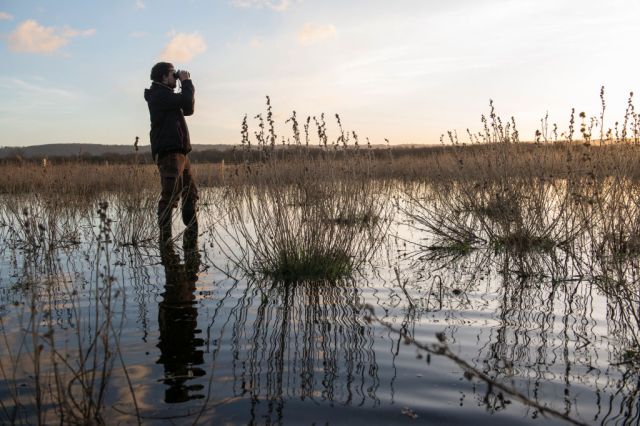So often, books about nature put human beings at the centre. Credit: Andia/Universal Images Group via Getty Images

Slippery things, eels. The sliminess of their skin, according to one Victorian wag, makes them as difficult to grasp as a pig “which has been well soaped.” This physical elusiveness is, of course, metaphor for the trickiness of pinning down the biology of the European eel. It is a fish that looks like a snake; stranger still, in its larval stage, as Tom Fort notes in his updated paeon to the eel, it most resembles an amoeboid, being “a flat transparent creature with a body shaped like a willow leaf and a tiny head with round black eyes and a pair of jaws armed with a few jagged teeth.” Eels metamorphose.
Fort, former Fishing Correspondent for the Financial Times, is a confirmed anguillophiliac. Which is reasonable. Eels are extraordinary things, seemingly put in the waters to make us wonder, and remember the continents of mysteries still left unsolved. They can slither headless. They also have the startling, un-fishy ability to travel overland. And they can live for an extraordinary length of time: an eel kept as a pet in Sweden — the creature was even given a name, Putte — turned silver belly up in 1948, at an estimated 88 years of age.
For millennia, the eel’s life cycle baffled humans. Aristotle believed that eels emerged from “the entrails of the earth,” while Pliny the Elder, usually a fairly sober scientist, concluded that eels replicated by rubbing their bodies against rocks, and “from the shreds of skin thus detached come new ones.” It would be easy to scoff, except that the fantastic truth of eel reproduction was only fully proven in 1921. “In so far that a story about a fish can have a human hero,” Fort writes “it is the Danish scientist Johannes Schmidt.” Sailing the Sargasso Sea, at 26°N, 54°W, aboard the good ship Dana, Schmidt finally discovered the species’ breeding grounds, ending millennia of speculation.
Eels spawn in the Sargasso wastes of the Atlantic, then the offspring — elvers, or ‘thin heads’ — drift with the current to Europe, where they become a freshwater species (another metamorphosis). They snout their way up estuaries and rivers; live 10, 20 years — or 80 if kept in a tank and fed by Swedes — then return to the ancestral spawning site one dark night, under some deus ex machina prompt. There, they mate in a giant, thrashing orgy, only to die and sink three miles down to the ocean floor. In this dark graveyard, their million macabre corpses are finally scavenged by the lowest form of marine life, holothuria, a creature that “breathes through its anus.”
Schmidt may have discovered the breeding grounds of Anguillia anguillia, but to this day no-one is sure how mature eels navigate the thousands of watery miles to their birthplace. As Seamus Heaney so memorably versed the riddle of eel migration:
Who knows now if she knows
Her depth and direction
She’s passed Malin and
Tory, silent, wakeless,
A wisp, a wick that is
Its own taper and light
Through the weltering dark
Eels also happen to taste very good, though they are now out of culinary fashion, except with the few remaining proper Cockneys and a couple of up-scale cooks — the former liking the fish stewed with ‘liquor’ (green parsley sauce), the latter smoked. Jane Grigson considered the eel quite possibly her favourite piscatus, the meat being “delicate but rich.” Then again, the proles and the posh have always tended to be nerveless about food, its eating and its killing; it’s only the middle classes who squirm. The same goes for war.
How times change. Eel fishing on the Thames, once a bustling business, is down to one solitary commercial fisher, Dave Pearce. His mates think he is “fucking mad.”
Sure. Who wants cold, hard graft? Someone should put a conservation order on Pearce. It is not just species of animal that are threatened with extinction, but species of people: the traditionals. Reading Fort’s book, I was reminded of the poacher in the Herefordshire village of my 70s childhood, who liked a tasty eel from the Wye, along with a spanking big salmon (sold out the back carpark of The Moon pub), both caught with illegal nets at night, which is the eel-time. Are there any real poachers like Percy left? Those absolute villains who were consummate naturalists, who knew the ways of the hare, the grey partridge, the roe deer? The eel?
Eel numbers have plummeted since the 1970s, so it is probably just as well we have lost our taste for its sweet white flesh. In 2007, the eel became “critically endangered.” This for a fish whose numbers were once so vast that on the night of 4 October 1697, the fishery at Comacchio in Italy caught 300 tons of migrating specimens, about three quarters of a million fish. In a single night.

Like everything about the eel, the reasons for its calamitous decline are mysterious, although shifts in the oceanic currents which bring the elvers to Europe and the pollution of waterways are causal contenders. And it is the eel’s bad luck to be enigmatic rather than charismatic. If it were feathery or furry, rather than serpenty and possessed of a catholicity of appetite (encompassing cannibalism), re-wilders would be launching 38 Degrees petitions on its behalf. But instead the beavers and the bison get all the love.
First published in 2002, Fort’s book did not do good cash, or as he puts it, “it cannot be said to have been a resounding commercial success.” Well, nature writing was dead in the water then. Now the genre — the oldest in the world, if you think about it, dating back to pictographs on cave walls — is in full flood, with writers such as Robert Macfarlane and myself making the Sunday Times bestseller chart.
So you would expect a book as good as this (marred only by some repetitiveness in eel-catching scenes towards the tail) to do well. I fear it won’t. Fort is swimming against the ideological current. With some notable exceptions, the New Nature Writing — which ironically thrives in inverse relation to actual nature — is more about human ego than about birds, bees, butterflies and beasties. Schematically, one might say that it boils down either to Heroic Me (author on Odyssean quest in search of hundreds of beetles/moths/raptors/whatever), or Misery Me (author saved from the megrims by a close encounter with nature, a ‘nature cure’).
There is, further, a definite eco-cultural consensus around re-wilding, and against the human usage of animals. Farming is the F-word in these circles. And vegetarianism the V for victory.
And unfortunately for Fort, he is a man who believes an eel’s place is on the plate as well as in the river, and who is only present in his text to humanise and explain, which is exactly the humble method of Britain’s Ur nature writer, Gilbert White, the Vicar of Selborne, born 300 years ago, whose meticulous country diaries, The Natural History and Antiquities of Selborne, have, extraordinarily, been in print continuously since publication in 1789.
The Reverend White would have loved The Book of Eels. You can bet he liked a dish of eels too.










Join the discussion
Join like minded readers that support our journalism by becoming a paid subscriber
To join the discussion in the comments, become a paid subscriber.
Join like minded readers that support our journalism, read unlimited articles and enjoy other subscriber-only benefits.
Subscribe